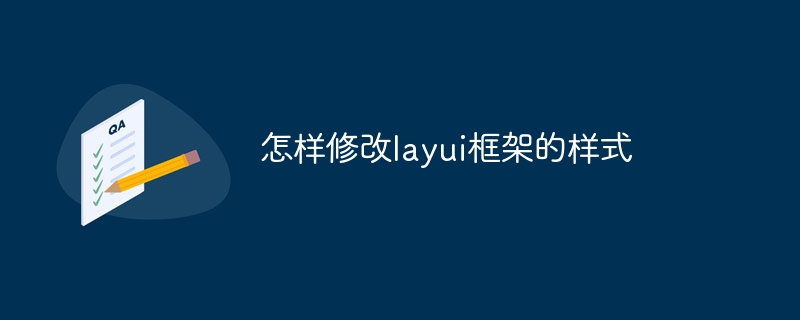How to modify the style of layui framework
How to modify the style of LayUI framework? Modify the CSS file directly: find the CSS selector of the corresponding element and modify the properties and values. Call the layer.use() function from JavaScript code: pass in a callback function and modify the style in it. Use layuiFilter() filters from JavaScript code: pass in a CSS selector and a callback function, and modify the style in the callback function. Modify the theme: Find the "theme" variable in the src/layui.js file and change it to your favorite theme name. Customize the theme: Create a new CSS file containing LayU

How to modify the style of the LayUI frame
Modify the CSS file directly
- Open the css/layui.css or layui.all.css file of the LayUI framework.
- Find the CSS selector of the corresponding element.
- Modify properties and values to customize styles.
Through the Layer.use() function
- Call the layer.use() function in JavaScript code.
- Pass in a callback function and modify the style in it.
layui.use('layer', function(){
layer.open({
title: '修改样式',
content: '修改元素样式',
success: function(layero, index){
// 修改标题背景色
layero.find('.layui-layer-title').css('background-color', '#f1f1f1');
}
});
});Through the layuiFilter() filter
- Use the layuiFilter() filter in JavaScript code.
- Pass in a CSS selector and a callback function, and modify the style in the callback function.
layui.filter('body', function(elem){
elem.css('background-color', '#fff');
});Modify Theme
- LayUI provides multiple built-in themes to easily change global styles.
- Find the "theme" variable in the src/layui.js file and change it to your favorite theme name.
Custom Theme
- #If you want to create your own theme, you can create a new CSS file and include LayUI's default styles.
- Then override the style of the element you want to modify.
- Link your CSS files to your HTML pages.
The above is the detailed content of How to modify the style of layui framework. For more information, please follow other related articles on the PHP Chinese website!

Hot AI Tools

Undresser.AI Undress
AI-powered app for creating realistic nude photos

AI Clothes Remover
Online AI tool for removing clothes from photos.

Undress AI Tool
Undress images for free

Clothoff.io
AI clothes remover

AI Hentai Generator
Generate AI Hentai for free.

Hot Article

Hot Tools

Notepad++7.3.1
Easy-to-use and free code editor

SublimeText3 Chinese version
Chinese version, very easy to use

Zend Studio 13.0.1
Powerful PHP integrated development environment

Dreamweaver CS6
Visual web development tools

SublimeText3 Mac version
God-level code editing software (SublimeText3)

Hot Topics
 1378
1378
 52
52
 How to write split lines on bootstrap
Apr 07, 2025 pm 03:12 PM
How to write split lines on bootstrap
Apr 07, 2025 pm 03:12 PM
There are two ways to create a Bootstrap split line: using the tag, which creates a horizontal split line. Use the CSS border property to create custom style split lines.
 The Roles of HTML, CSS, and JavaScript: Core Responsibilities
Apr 08, 2025 pm 07:05 PM
The Roles of HTML, CSS, and JavaScript: Core Responsibilities
Apr 08, 2025 pm 07:05 PM
HTML defines the web structure, CSS is responsible for style and layout, and JavaScript gives dynamic interaction. The three perform their duties in web development and jointly build a colorful website.
 How to use bootstrap in vue
Apr 07, 2025 pm 11:33 PM
How to use bootstrap in vue
Apr 07, 2025 pm 11:33 PM
Using Bootstrap in Vue.js is divided into five steps: Install Bootstrap. Import Bootstrap in main.js. Use the Bootstrap component directly in the template. Optional: Custom style. Optional: Use plug-ins.
 How to insert pictures on bootstrap
Apr 07, 2025 pm 03:30 PM
How to insert pictures on bootstrap
Apr 07, 2025 pm 03:30 PM
There are several ways to insert images in Bootstrap: insert images directly, using the HTML img tag. With the Bootstrap image component, you can provide responsive images and more styles. Set the image size, use the img-fluid class to make the image adaptable. Set the border, using the img-bordered class. Set the rounded corners and use the img-rounded class. Set the shadow, use the shadow class. Resize and position the image, using CSS style. Using the background image, use the background-image CSS property.
 How to resize bootstrap
Apr 07, 2025 pm 03:18 PM
How to resize bootstrap
Apr 07, 2025 pm 03:18 PM
To adjust the size of elements in Bootstrap, you can use the dimension class, which includes: adjusting width: .col-, .w-, .mw-adjust height: .h-, .min-h-, .max-h-
 How to set up the framework for bootstrap
Apr 07, 2025 pm 03:27 PM
How to set up the framework for bootstrap
Apr 07, 2025 pm 03:27 PM
To set up the Bootstrap framework, you need to follow these steps: 1. Reference the Bootstrap file via CDN; 2. Download and host the file on your own server; 3. Include the Bootstrap file in HTML; 4. Compile Sass/Less as needed; 5. Import a custom file (optional). Once setup is complete, you can use Bootstrap's grid systems, components, and styles to create responsive websites and applications.
 How to use bootstrap button
Apr 07, 2025 pm 03:09 PM
How to use bootstrap button
Apr 07, 2025 pm 03:09 PM
How to use the Bootstrap button? Introduce Bootstrap CSS to create button elements and add Bootstrap button class to add button text
 How to view the date of bootstrap
Apr 07, 2025 pm 03:03 PM
How to view the date of bootstrap
Apr 07, 2025 pm 03:03 PM
Answer: You can use the date picker component of Bootstrap to view dates in the page. Steps: Introduce the Bootstrap framework. Create a date selector input box in HTML. Bootstrap will automatically add styles to the selector. Use JavaScript to get the selected date.




